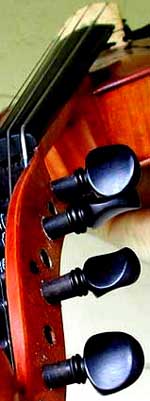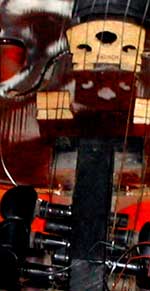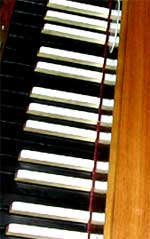 | |||||||

|
Temperament from the Märzmusik Festival catalogue Berliner Festspiele, 2004. |
||
|
Temperament is a project from Jon Rose (strings) and Veryan Weston (keyboards) that explores, through the means of virtuosic improvisation, tempered and non equal tempered tunings derived from science, history and the imagination. They utilise the special sonorities available in such ancient instruments as the Forte Piano, the Harpsichord, and the Positive Organ; also fundamental to the duo's unique sound are the Tenor Violin, the 8 String Hybrid Tenor (The Bird) and the monstrous 10 string double violin, all played scordatura. How does it sound? The duo's approach to say 'Just Intonation' is typically fresh and un-academic, enjoying the differing characteristics of all the 'out of tune' thirds as well as the perfectly Just 'in tune' major and minor third. Concerts from this duo often finish with a medley of Italian and Hungarian popular tunes. The Failure of Equal Temperament First, it is important to explain what temperament is. In the Oxford Junior Companion to Music, Equal Temperament is amusingly defined as 'a way of tuning instruments that is convenient but not quite correct.' So what is correct? To understand the correctness of tuning, it is important to realise the natural laws of sound vibration and its measurement. 'The pitch of a note depends entirely on the frequency of its vibration' (Ottó Károlyi - Introducing Music, p.13). By dividing these frequencies equally, it is possible to obtain perhaps what the dictionary describes as correct musical intervals, i.e. intervals that adhere to the natural laws of physics. But these equally divided frequencies lead to unequal temperaments (ways of tuning an instrument). These so-called unequal temperaments are the result of more natural agrarian laws. It is not insignificant that music with these correct intervals is more likely to be found in ethnic music cultures where natural laws have not been replaced by cultivated human laws. So why is the cultivated view of equal temperament based on an illogicality--in other words, where the frequencies are no longer divided equally? There are many reasons for these imposed cultivated laws, a major one being as a result of what Marx describes in The German Ideology: The division of labour inside a nation leads at first to the separation of industrial and commercial from agricultural labour, and hence to the separation of town and country and to the conflict of their interests. Its further development leads to the separation of commercial to industrial labour. At the same time through the division of labour inside these various branches there develop various divisions among the individuals co-operating in definite kinds of labour. The relative position of these groups is determined by the methods employed in agriculture, industry and commerce (patriarchialism, slavery, estates, classes). For the last 400 years, an ironically similar period for which slavery of another kind was in existence in Europe, the use of unequal temperament was slowly banished as the dictates of the composer demanded an irreducible unit of pitch capable of unproblematic modulation.. In the Baroque period, just before the final codification of all pitch organisation, there were well over one hundred possibilities for constructing different gradations between each pitch within twelve divisions of a scale. Tuning systems such as Meantone, Kirnberger, Silbermann, and Vallotti emphasized the different sounds of home keys, and an improvisationary modulation to a distant key was a truely exotic sonic journey. When Bach wrote his two books of Well Tempered Clavier music, he meant 'well' not 'even' as is commonly misrepresented. In other words, every key was meant to have a distinct personality and sound; whereas today, every key in equal temperament is identical - every semitone difference between each note is identical. For example, with the French Temperament Ordinaire tuning system, Pierre Lewis explains the consequence of its makeup: In the near keys, the thirds are much purer and the fifths less so than in the remote keys. In the near keys, irregular temperaments resemble meantone, and in the remote keys, they resemble (the near keys of) Pythagoras' tuning (with the tense thirds). This gives added variety to modulation, which was appreciated in the past. As the industrial revolution took Europe by the scruff of its neck, the freedoms and vitality of different and irregular tunings were superceded by a system that insisted on an industrial standard. This standard has aided and abetted the practice of western music within its strict hierachies by the control and means of production perversely separated into that classic mind/body split of composer and the hack musician. The codification, copyrighting, publishing, and selling of music in the form of notation has cemented that destructive relationship. The system of equal temperament helps to provide one of the most rigid musical boundaries within music. It embraces and informs the sound of everything we are fed --from Bill Haley and the Three Tenors to the latest manufactured boys' band. In the last forty years, a few composers like Partch have discovered the world of temperament and others like Xenakis have worked with micro tonal intervals; amongst improvising musicians however, the challenges and possibilities of temperaments and tunings have largely been ignored. Recent reductive minimalist trends in improvised music indicate even less interest in issues of pitch than before. The Weston/Rose duo seeks to re-open those doors which have long been closed. As our double album of improvisations using different temperaments (for the keyboards) and different scordatura (for the violins) states - our approach may be derived from science, history and the imagination, but it remains unacademic and empirical. The science and theory have been done, but there is still much to explore and test. For example, tuning a keyboard to Just C may create a perfectly 'in tune' third in which the proportions are 5/4, but it also creates eleven other versions of the major third, some of which may make your ears spin. A composer would probably ignore all this timbral mayhem and dissonance, just keeping the music in a perfect C major. We, however, relish this world of sonic relativities and impurities. Every time a violinist plays a major third double stop, no matter how 'in tune' it may appear, it vibrates differently. Our duo welcomes a dialogue where the many tuning options for keyboards are also considered. It is worth noting too that each tuning system brings with it not just changes in pitches but changes to the whole resonance of an acoustic instrument. A simple domestic upright piano tuned to Just Intonation becomes a new, undiscovered instrument. The last hundred years of history has also singled out the violinist for a particularly bad deal - the fate of being chained to the piano through endless pedgagogy and having to play all those sonatas. It's hard enough to play in tune on the violin, but our hapless fiddler has been told to play 'in tune' with the willfully 'out of tune' piano. Not only that, but the piano has become an industrialised monster in size, in volume, and in timbre. It is fair to say that the modern Steinway and the violin have little in common. When the two appear on stage together, the piano's volume must be severely reduced, so the lid is kept almost shut. This compounds the problem of lack of grain in the modern instrument (compared to the pianos of Mozart and Beethoven), making its tone muted and bland; so rather than bringing the two instruments closer together, the gulf between the two iconic pillars of western music is emphasised. Rather than use amplification for the violin, we select instruments that speak to each other timbrally and tonally on intimate terms. Thus, the harmonium, the harpsichord, the forte piano (designed by Stein, Walter, and Graff), the positive organ, and the domestic re-tuned upright piano lock horns with the tenor violin, the ten-string double violin, the eight-string tenor d'amore, the sixteen-string long neck, and the plain vanilla four-string fiddle. Using improvisation as the basic method of musical activity enables us an equal share in the creation of continuing fresh musical ideas and mobile structures. © Veryan Weston and Jon Rose 2004 |
 |







